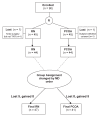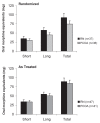Patient-controlled oral analgesia for postoperative pain management following total knee replacement
- PMID: 20195553
- PMCID: PMC2855290
- DOI: 10.1155/2010/528092
Patient-controlled oral analgesia for postoperative pain management following total knee replacement
Abstract
Purpose: To investigate whether patient-controlled oral analgesia (PCOA) used by individuals receiving a total knee replacement could reduce pain, increase patient satisfaction, reduce opioid use and/or reduce opioid side effects when compared with traditional nurse (RN)-administered oral analgesia.
Methods: Patients who underwent an elective total knee replacement at a quaternary care centre (Toronto Western Hospital, Toronto, Ontario) were randomly assigned to either PCOA or RN-administered short-acting oral opioids on postoperative day 2. Subjects in the RN group called the RN to receive their prescribed short-acting opioid. Subjects in the PCOA group kept a single dose of their prescribed oral opioid at their bedside and took this dose when they felt they needed it, to a maximum of one dose every 2 h. Study outcomes, collected on postoperative day 2, included pain (measured by the Brief Pain Inventory - Short Form), patient satisfaction (measured by the Pain Outcome Questionnaire Satisfaction subscale - component II), opioid use (oral morphine equivalents), opioid side effects (nausea, pruritus and/or constipation) and knee measures (maximum passive knee flexion and pain at maximum passive knee flexion, performed on the operative knee).
Results: Study outcomes were analyzed twice. First, for a subset of 73 subjects who remained in their randomly assigned group (PCOA group, n=36; RN group, n=37), randomized analyses were performed. Second, for the larger sample of 88 subjects who were categorized by their actual method of receiving oral opioids (PCOA group, n=41; RN group, n=47), as-treated analyses were performed. There were no differences in study outcomes between the PCOA and RN groups in either analysis.
Conclusion: PCOA was not superior to RN administration on study outcomes. However, PCOA did not increase opioid use or pain. PCOA remains an important element in the patient-centred care facility.
OBJECTIF :: Examiner si l’analgésie orale contrôlée par les patients (AOCP) utilisée par les personnes qui subissent une arthroplastie totale du genou peut réduire la douleur, accroître la satisfaction du patient, réduire le recours aux opiacés ou les effets secondaires des opiacés par rapport à une analgésie orale classique administrée par une infirmière.
MÉTHODOLOGIE :: Les patients qui ont subi une arthroplastie totale du genou non urgente à un centre de soins quaternaires (Toronto Western Hospital de Toronto, en Ontario) ont été répartis au hasard entre une AOCP ou des opiacés oraux à action brève administrés par une infirmière le deuxième jour postopératoire. Les sujets du groupe traité par l’infirmière l’appelaient pour recevoir leur opiacé à action brève prescrit, tandis que le groupe de patients sous AOCP conservaient une dose unique d’opiacé oral prescrit à leur chevet et la prenaient lorsqu’ils en ressentaient le besoin, jusqu’à concurrence d’une dose aux deux heures. Les issues de l’étude, colligées le deuxième jour postopératoire, incluaient la douleur (mesurée selon le bref inventaire de la douleur – court), la satisfaction du patient (mesurée selon la sous-échelle de satisfaction du questionnaire d’issue de la douleur – élément II), le recours aux opiacés (équivalents oraux de la morphine), les effets secondaires des opiacés (nausées, prurit ou constipation) et les mesures du genou (flexion passive maximale du genou et douleur lors de la flexion passive maximale du genou opéré).
RÉSULTATS :: Les chercheurs ont analysé les issues de l’étude deux fois. D’abord, dans un sous-groupe de 73 sujets demeurés dans leur groupe attribué au hasard (groupe sous AOCP, n=36; groupe traité par l’infirmière, n=37), ils ont effectué des analyses randomisées. Ensuite, au sein du plus grand échantillon de 88 sujets classés selon la méthode réelle d’administration des opiacés (groupe sous AOCP, n=41; groupe traité par l’infirmière, n=47), ils ont procédé à des analyses selon le traitement. Dans les deux analyses, ils n’ont constaté aucune différence d’issues entre le groupe sous AOCP et celui traité par l’infirmière.
CONCLUSION :: L’AOCP n’était pas supérieure à l’administration par l’infirmière pour les issues de l’étude. Cependant, l’AOCP n’accroissait pas l’utilisation des opiacés ou la douleur. L’AOCP demeure un élément important dans l’établissement de soins axés sur les patients.
Figures



Similar articles
-
Nursing knowledge and beliefs regarding patient-controlled oral analgesia (PCOA).Pain Manag Nurs. 2013 Dec;14(4):318-326. doi: 10.1016/j.pmn.2011.07.003. Epub 2011 Oct 6. Pain Manag Nurs. 2013. PMID: 24315254
-
Effects of perioperative administration of a selective cyclooxygenase 2 inhibitor on pain management and recovery of function after knee replacement: a randomized controlled trial.JAMA. 2003 Nov 12;290(18):2411-8. doi: 10.1001/jama.290.18.2411. JAMA. 2003. PMID: 14612477 Clinical Trial.
-
Long-acting morphine following hip or knee replacement: a randomized, double-blind, placebo-controlled trial.Pain Res Manag. 2012 Mar-Apr;17(2):83-8. doi: 10.1155/2012/704932. Pain Res Manag. 2012. PMID: 22518369 Free PMC article. Clinical Trial.
-
Patient-Controlled Analgesia (PCA): Intravenous Administration (IV-PCA) versus Oral Administration (Oral-PCA) by Using a Novel Device (PCoA® Acute) for Hospitalized Patients with Acute Postoperative Pain-A Comparative Retrospective Study.Pain Res Manag. 2021 May 4;2021:2542010. doi: 10.1155/2021/2542010. eCollection 2021. Pain Res Manag. 2021. PMID: 34055117 Free PMC article. Review.
-
Effect of morphine added to multimodal cocktail on infiltration analgesia in total knee arthroplasty: A meta-analysis of randomized controlled trials.Medicine (Baltimore). 2019 Oct;98(41):e17503. doi: 10.1097/MD.0000000000017503. Medicine (Baltimore). 2019. PMID: 31593120 Free PMC article.
Cited by
-
Patient Performance of Care Tasks During Acute Hospitalisation: A Scoping Review.J Clin Nurs. 2025 Jul;34(7):2573-2590. doi: 10.1111/jocn.17668. Epub 2025 Jan 24. J Clin Nurs. 2025. PMID: 39861958 Free PMC article.
-
Effectiveness of Interventions to Reduce Opioid Use After Orthopaedic Surgery: A Systematic Review of Randomised Controlled Trials.Drugs. 2025 Mar;85(3):385-396. doi: 10.1007/s40265-024-02116-2. Epub 2024 Dec 20. Drugs. 2025. PMID: 39702868 Free PMC article.
-
Patient directed self management of pain (PaDSMaP) compared to treatment as usual following total knee replacement: study protocol for a randomized controlled trial.Trials. 2012 Nov 5;13:204. doi: 10.1186/1745-6215-13-204. Trials. 2012. PMID: 23126312 Free PMC article. Clinical Trial.
-
A randomized controlled trial of postoperative analgesia following total knee replacement: transdermal Fentanyl patches versus patient controlled analgesia (PCA).Eur J Orthop Surg Traumatol. 2015 Aug;25(6):1073-9. doi: 10.1007/s00590-015-1621-6. Epub 2015 Mar 11. Eur J Orthop Surg Traumatol. 2015. PMID: 25753087 Clinical Trial.
-
Factors associated with success and failure of patient-controlled oral analgesia after total hip and knee arthroplasty: a historical comparative cohort study.Can J Anaesth. 2021 Mar;68(3):324-335. doi: 10.1007/s12630-020-01864-5. Epub 2020 Nov 17. Can J Anaesth. 2021. PMID: 33205265 English.
References
-
- Apfelbaum JL, Chen C, Mehta SS, Gan TJ. Postoperative pain experience: Results from a national survey suggest postoperative pain continues to be undermanaged. Anesth Analg. 2003;97:534–40. - PubMed
-
- Coley KC, Williams BA, DaPos SV, Chen C, Smith RB. Retrospective evaluation of unanticipated admissions and readmissions after same day surgery and associated costs. J Clin Anesth. 2002;14:349–53. - PubMed
-
- Watt-Watson J, Garfinkel P, Gallop R, Stevens B, Streiner D. The impact of nurses’ empathic responses on patients’ pain management in acute care. Nurs Res. 2000;49:191–200. - PubMed
-
- Watt-Watson J, Stevens B, Costello J, Katz J, Reid G. Impact of preoperative education on pain management outcomes after coronary artery bypass graft surgery: A pilot. Can J Nurs Res. 2000;31:41–56. - PubMed
-
- Trueblood A, Manning DW. Analgesia following total knee arthroplasty. Curr Opin Orthop. 2007;18:76–80.
Publication types
MeSH terms
Substances
LinkOut - more resources
Full Text Sources

